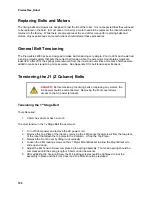
87
selected to allow enough motor torque to overcome the spring and still provide reasonable opening force
for inside grips.
The motor for the 23N gripper can apply about 18N of force at its rated current of 1.26A. When closing
the fingers the motor adds its force to the spring force, so a maximum closing force of about 24-26N is
possible, depending on portrait or landscape gripping. When opening, the motor must oppose the spring
force, so a maximum opening force of about 8- 12N is possible, depending on the opening of the fingers.
The motor squeeze force can be limited by modifying the rated current of the motor. This can be done by
writing into the 5
th
field in Parameter Data Base # 10611. The motor current can be set once and saved
into flash or modified dynamically by a GPL program using the Controller.PDbNum instruction.
For the 23N gripper the formula for determining the approximate gripper squeeze is 7N +( Rated
Current/1.26Amps)X18N for squeeze and ( Rated Current/1.26Amps)X18N –9N for gripper opening force.
For the 60N gripper the formula for determining the approximate gripper squeeze is 7N +( Rated
Current/2.0Amps)X53N for squeeze and ( Rated Current/2.0Amps)X53N –9N for gripper opening force.
Note that in order to home the gripper must open all the way its maximum hard stop. The spring force at
this point is about 10N. So the motor current should not be set below about 12N/18NX1.26A or 0.8A for
the simple method of controlling gripper squeeze, giving a range of about 18N minimum to 24N maximum
squeeze for the 23N gripper.
Gripper Squeeze (Asymmetric Method)
There may be cases where 18N of squeeze is too much. In this case there is a more sophisticated
method to control squeeze.
There are two parameters in the database, 10351 and 10352 that can be used to limit the torque from the
PID loop in the positive and negative directions. These parameters were developed to limit the
downwards force of a robot running with dynamic feedforward, where the dynamic feedforward
compensates for the gravity torque of the robot. The feedforward torque is NOT limited by these
parameters, only the PID torque. So for a perfectly balanced robot, setting these parameters to a low
value for a gravity loaded axis limits the maximum force the axis can apply from any position error. So if
the axis crashes into a hard stop, the downwards or upwards force can be limited to a small value.
These same parameters can be used to limit the gripper squeeze in an asymmetric manner. Parameter
10352 can be set to a negative value of torque counts (tcnts) to limit the torque from the PID loop in the
controller in the negative direction only. Parameter 10351 can similarly be set to limit tcnts from the PID
loop in the positive direction. Since the spring compensation in the gripper is treated as a feedforward
torque, these parameters do not affect the spring compensation torque.
For this case it is more exact to know the exact number of tcnts to oppose the spring at various openings.
For the portrait mode opening of 83mm it takes 1600 tcnts to oppose the spring. For the landscape mode
opening of 123mm it takes 2200 tcnts to oppose the spring.
If the rated torque of the motor has been set to its maximum value of 1.26A, the formula for setting
parameter 10352 is (Spring force at position) +( (-<Contents of 10352>-<tcnts to oppose spring
force>)/4378)X18N, where 4378 is the number of tcnts corresponding to 1.26A or the rated torque of the
motor. For example, for portrait mode the spring force is about 6N, and if the contents of 10352 are -
3200, this value will be 6N + (3200-1600)/4378)X18N or about 12.5N. If the value of 10352 is -1600, the
squeeze will be 6N which is the spring force only.
Summary of Contents for PF3400
Page 8: ......
Page 32: ...PreciseFlex_Robot 24 Appendix B TUV Verification of PF400 Collision Forces...
Page 33: ...Introduction to the Hardware 25...
Page 34: ...PreciseFlex_Robot 26...
Page 35: ...Introduction to the Hardware 27...
Page 37: ...Introduction to the Hardware 29 Appendix C Table A2 from ISO TS 15066 2016...
Page 38: ...PreciseFlex_Robot 30 Table A2 Continued...
Page 41: ...Introduction to the Hardware 33 PF400 500gm Safety Circuits PF3400 3kg Safety Circuits...
Page 45: ...Installation Information 37...
Page 46: ...PreciseFlex_Robot 38...
Page 47: ...Installation Information 39...
Page 48: ...PreciseFlex_Robot 40...
Page 54: ...PreciseFlex_Robot 46 Schematic System Overview...
Page 55: ...Hardware Reference 47 Schematic FFC Boards Revision B PF400...
Page 56: ...PreciseFlex_Robot 48...
Page 57: ...Hardware Reference 49 Schematic FFC Boards Revision C PF400...
Page 58: ...PreciseFlex_Robot 50 Schematic FFC Boards 3kg PF400...
Page 59: ...Hardware Reference 51...
Page 60: ...PreciseFlex_Robot 52 Schematic Safety System Overview PF400 CAT3...
Page 61: ...Hardware Reference 53...
Page 62: ...PreciseFlex_Robot 54 Controller Power Amplifier Connectors Control Board Connectors...
Page 63: ...Hardware Reference 55 Gripper and Linear Axis Controller Connectors...
Page 64: ...PreciseFlex_Robot 56...
Page 65: ...Hardware Reference 57...
Page 66: ...PreciseFlex_Robot 58 Schematic Slip Ring for 60N Gripper...
Page 67: ...Hardware Reference 59...
Page 68: ...PreciseFlex_Robot 60...
Page 69: ...Hardware Reference 61...
Page 70: ...PreciseFlex_Robot 62...
Page 71: ...Hardware Reference 63...
Page 72: ...PreciseFlex_Robot 64...
Page 73: ...Hardware Reference 65 Motor 60N Gripper...
Page 74: ...PreciseFlex_Robot 66...
Page 106: ...PreciseFlex_Robot 98 b The CALPP application takes about 1 minute to run...
Page 124: ...PreciseFlex_Robot 116 Wiring for 60N Gripper with Battery Pigtail Wiring for Pneumatic Gripper...
Page 125: ...117 Wiring for Vacuum Gripper Wiring for Vacuum Pallet Gripper...
















































